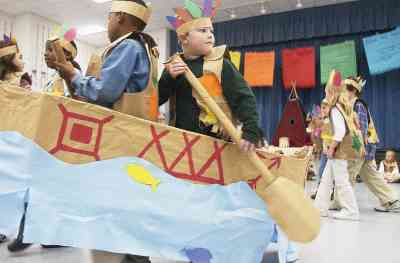By Jasmine Linabary
The two-day trip, funded through Indian Education for All money, was meant to allow Bigfork students to get to know their peers on the Blackfeet Indian Reservation. Bigfork High School teacher Hans Bodenhamer, who worked as a teacher in Browning for six years before coming to Bigfork, said he noticed a lot of negative attitudes about the reservation and his experience had been the opposite. This was why he has taken a group of students on a trip to Browning the last two years and why many of the students themselves decided to go.
"You hear a lot about reservations and not all of it is good," BHS senior Lena Olson said. "I wanted to figure it out for myself."
Nine BHS students and 15 students from Blackfeet Academy, Browning's alternative high school, teamed up and experienced a tour of Browning, rode horses bareback and climbed a buffalo jump, among other activities including a shared meal Friday, Jan. 22.
Several students went on the trip last year when Bodenhamer first set up the visit and were anxious to go again. In fact, it was at their "pestering" that Bodenhamer said he decided to do the trip a second time.
Olson said she was nervous the first year, not really knowing what to expect or how she'd respond. Others shared similar sentiments.
"Going in, I thought they would all be the same," senior Cassie Campbell said. "But they are all different, just like us."
"Getting groups together, I think, is one of the strongest ways to do it," he said.
Other experiences with Native American culture the students remembered experiencing include making moccasins in art class and learning a bit about it in U.S. history classes.
"You can read about a culture in textbooks, but you never really know about it until you experience it," Olson said.
A typical Thanksgiving pageant or classroom project to make paper headdresses is something like three degrees removed from reality. It bears almost no relationship to the Native reality today.
A history lesson, a textbook, or an instructor showing beads and moccasins is two degrees removed from reality. Even if the information is accurate, it's 1) conveyed by non-Indians, and 2) presenting Indians as people of the past.
If these approaches include info on today's Indians, they still may be counterproductive. The message kids get is "Indians: past, past, past, past, past--and, oh yeah, a little bit of the present." The "past" part usually predominates, leaving kids with the belief that Indians are historical artifacts. That they're like a coelacanth fish that just happened to survive from prehistoric times.
Even meeting modern Indians in class, or seeing them in movies or TV shows, is one degree removed from reality. Seeing a few healthy, wholesome Indians doesn't necessarily contradict the stereotypes: that Indians are lazy drunks, reservations are hellholes of crime and poverty, Indians don't pay taxes and are rich from casinos, etc.
Actually going to a reservation or a powwow, seeing it with your own eyes, is undoubtedly the most effective means of educating people. If studies haven't proved this already, someone should do a study on the alternatives I've listed above. Assuming I'm right, let's get rid of the headdresses, beads, and moccasins and add field trips to school curricula.
For more on the subject, see Phony Tribes, Headdresses, Totem Poles and "Grey Eagle" Teaches Stereotypes.
Below: The kind of lame lesson schoolkids shouldn't be getting.


No comments:
Post a Comment